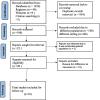Onset and predictors of first-line antiretroviral therapy treatment failure among children in Ethiopia: a systematic review and meta-analysis
- PMID: 39731032
- PMCID: PMC11673881
- DOI: 10.1186/s12887-024-05324-7
Onset and predictors of first-line antiretroviral therapy treatment failure among children in Ethiopia: a systematic review and meta-analysis
Abstract
Introduction: The emergence of First-line Antiretroviral Therapy (ART) regimens fails; it necessitates the use of more costly and less tolerable second-line medications. Therefore, it is crucial to identify and address factors that increase the likelihood of first-line ART regimen failure in children. Although numerous primary studies have examined the incidence of first-line ART failure among HIV-infected children in Ethiopia, national-level data on the onset and predictors remain inconsistent. Hence, this study was conducted to fill the gaps in determining the onset of first-line ART failure and its predictors among HIV-infected children in Ethiopia.
Methods: Articles related to our topic of interest were searched using a systematic approach in national and international electronic databases. The retrospective follow-up cohort studies published in English up to 2022 were included. The data were extracted using a Microsoft Excel spread sheet and exported into Stata™ Version 17.0 for further management and analysis. The level of heterogeneity was quantified using I2 test together with a 95% confidence interval (CI). The incidence of the primary estimates was estimated using a random effects model in the Dersimonian-Lairedmethod. Subgroup analysis, Meta regression, and sensitivity analysis were computed to identify the source of heterogeneity but not explained. The predictors of first-line ART failure were explained using relative risk (RR) with 95% confidence interval (CI).
Results: Ten studies having a total of 5446 children were included. The pooled onset of first-line ART failure was 3.18 (95% CI: 1.91, 4.44) per 100 child-years of observations. Those study participants who began ART at an advanced WHO clinical stage at ART initiation had a 3.05 (95% CI: 1.47, 6.36), having poor ART adherence had a 2.19 (95% CI: 1.29, 3.70), and having TB-HIV coinfection at ART initiation had a 1.43 (95% CI: 1.06, 1.94) times higher chance of experiencing first-line ART failure than their corresponding counterparts.
Conclusion: The onset of first-line ART failure was high to achieve the 2030 UNAIDS target of ending the AIDS epidemic. Advanced WHO clinical stage, poor first-line ART adherence, and having TB-HIV coinfection were identified predictors. Hence, community HIV screening should continue to strengthen early ART initiation, and the attention of ART adherence should be kept to achieve ending the AIDS epidemic. The baseline tests and diagnosis, like TB diagnosis should be maintained for HIV-infected children while they begin ART.
Keywords: Children; Ethiopia; First-line ART failure; Onset; Predictors.
© 2024. The Author(s).
Conflict of interest statement
Declarations. Ethics approval and consent to participate: Not applicable’ for this section because it was conducted using secondary data. Consent for publication: Not applicable” in this section. Competing interests: The authors declare no competing interests.
Figures









Similar articles
-
Incidence and predictors of treatment failure among children on first-line antiretroviral therapy in Amhara Region Referral Hospitals, northwest Ethiopia 2018: A retrospective study.PLoS One. 2019 May 1;14(5):e0215300. doi: 10.1371/journal.pone.0215300. eCollection 2019. PLoS One. 2019. PMID: 31042743 Free PMC article.
-
Mortality and its predictors among human immunodeficiency virus-infected children younger than 15 years receiving antiretroviral therapy in Ethiopia: a systematic review and meta-analysis.BMC Infect Dis. 2024 May 3;24(1):471. doi: 10.1186/s12879-024-09366-1. BMC Infect Dis. 2024. PMID: 38702591 Free PMC article.
-
Incidence and predictors of common opportunistic infections among children less than 15 years of age on antiretroviral therapy in Ethiopia: a systematic review and meta-analysis.BMC Infect Dis. 2025 Apr 12;25(1):519. doi: 10.1186/s12879-025-10945-z. BMC Infect Dis. 2025. PMID: 40221651 Free PMC article.
-
Opportunistic infections among schoolchildren who were on antiretroviral therapy in Ethiopia: a systematic review and meta-analysis.Front Pediatr. 2024 Nov 22;12:1255111. doi: 10.3389/fped.2024.1255111. eCollection 2024. Front Pediatr. 2024. PMID: 39649399 Free PMC article.
-
Incidence of tuberculosis and its predictors among children on antiretroviral therapy in Amhara Region, Ethiopia: a multicentre institution-based retrospective follow-up study.BMJ Open. 2025 Feb 13;15(2):e093808. doi: 10.1136/bmjopen-2024-093808. BMJ Open. 2025. PMID: 39947830 Free PMC article.
References
-
- World Health Organization. Taking stock: HIV in children: the state of affairs. Geneva: World Health Organization; 2006.
-
- Yayehirad AM, Mamo WT, Gizachew AT, Tadesse AA. Rate of immunological failure and its predictors among patients on highly active antiretroviral therapy at Debremarkos hospital, Northwest Ethiopia: a retrospective follow up study. J AIDS Clin Res. 2013;14(5):1–4.
-
- FMoHo E. National consolidated guidelines for comprehensive HIV prevention, care and treatment. Geneva: World Health Organization; 2020.
Publication types
MeSH terms
Substances
LinkOut - more resources
Full Text Sources
Medical

